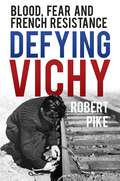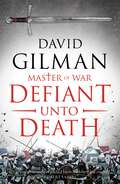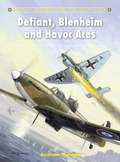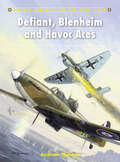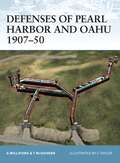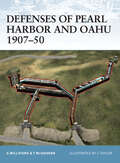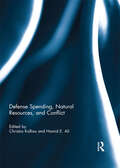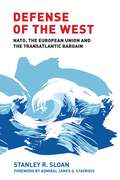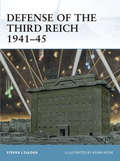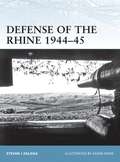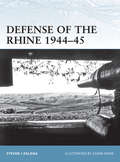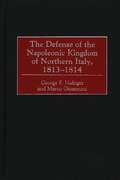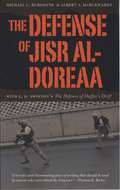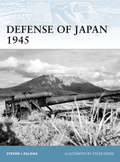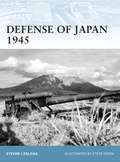- Table View
- List View
The Degradation of Ethics Through the Holocaust
by Paul E. WilsonThis book discusses ethical behavior through the genocidal stages of the Holocaust. Paul E. Wilson first looks at the antisemitism in Germany and Europe beginning in the decades preceding the Nazis reign of terror, and goes on to discuss the ethical decisions made in the initial stages that moved society toward genocide. The author maintains that the stages of genocide represent subtle changes that can be happening within a society in response to the moral choices made by actors. By giving attention to the stages of genocide in the Holocaust, this book contributes to the overall understanding of how the Holocaust was possible, and encourages the moral community to join the watch for the development of genocide in the modern world.
Defying Vichy: Blood, Fear and French Resistance
by Robert PikeVichy France under Marshal Pétain was an authoritarian regime that sought to perpetuate a powerful place for France in the world alongside Germany. It echoed the right-wing ideals of other fascist states and was a perfect instrument for Hitler, who drew more and more power and resources from a beaten France whose people suffered. Resistance was an unknown until a small number sought to make a stand in whatever way they could. Each would play their part in destabilising the Vichy state, all the while rejecting the Nazi occupation of their eternal France. The Dordogne was one of many hotbeds of early refusal and its dramatic stories are here told against the backdrop of the rise and fall of Vichy France. These stories, like so many others of often ordinary people – men and women, young and old – tell of a period of betrayal, refusal and heroism.
Defiant Unto Death (Master of War #2)
by David Gilman'Heart-pounding action' THE TIMES. FRANCE: 1356. Ten years ago, the greatest army in Christendom was slaughtered at Crécy. Archer Thomas Blackstone stood his ground and left that squalid field a knight. He has since carved out a small fiefdom in northern France, but the wounds of war still bleed and a traitor has given the King of France the means to destroy the English knight and his family. As the traitor's net tightens, so the French King's army draws in. Blackstone will stand and fight. He will defy his friends, his family and his king. He may yet defy death, but he can't defy his destiny: MASTER OF WAR.
Defiant, Blenheim and Havoc Aces (Aircraft of the Aces)
by Chris Davey Andrew ThomasThe Blenheim IF flew some of Fighter Command's early offensive operations, and the type soon proved vulnerable when pitted against single-seat fighters. However, for much of 1940 the Blenheim fighter squadrons provided the RAF's main long-range convoy escort and nightfighter capability. In the mid-1930s, in an attempt to capitalise on its expertise in power-operated gun turrets, the Boulton Paul Company developed the Defiant, a single-engined fighter in which all the armament was concentrated in the turret behind the pilot. Intended as a 'bomber destroyer', the Defiant had its combat debut over Dunkirk, and initially achieved some considerable success. A number of American-built aircraft called Douglas DB-7 light bombers (named Havoc by the RAF), were fitted with radar for nightfighter duties and others successfully replaced the Blenheim as night intruders. A total of 11 pilots claimed five or more victories when flying these three types to become aces, whilst no fewer than 33 who became aces claimed at least part of their scores when flying the Blenheim, Defiant or Havoc.
Defiant, Blenheim and Havoc Aces (Aircraft of the Aces #105)
by Andrew ThomasThe Blenheim IF flew some of Fighter Command's early offensive operations, and the type soon proved vulnerable when pitted against single-seat fighters. However, for much of 1940 the Blenheim fighter squadrons provided the RAF's main long-range convoy escort and nightfighter capability. In the mid-1930s, in an attempt to capitalise on its expertise in power-operated gun turrets, the Boulton Paul Company developed the Defiant, a single-engined fighter in which all the armament was concentrated in the turret behind the pilot. Intended as a 'bomber destroyer', the Defiant had its combat debut over Dunkirk, and initially achieved some considerable success. A number of American-built aircraft called Douglas DB-7 light bombers (named Havoc by the RAF), were fitted with radar for nightfighter duties and others successfully replaced the Blenheim as night intruders. A total of 11 pilots claimed five or more victories when flying these three types to become aces, whilst no fewer than 33 who became aces claimed at least part of their scores when flying the Blenheim, Defiant or Havoc.
Defiant: The Untold Story of the Battle of Britain
by Robert Verkaik'Robert Verkaik tells the story of the Battle of Britain's unlikeliest hero with verve and phenomenal grasp of detail. He brings the Defiant fighter back into focus as an important part of the victorious RAF in the hour of its greatest trial'Mark Urban'Meticulously researched and rich in human and social as well as military interest, Defiant fills a crucial gap in our understanding of that most perilous time' David Kynaston, author of Austerity Britain'Firmly establishes the aircraft's role in those crucial aerial battles of 1940 and elevates the brave aircrews who fought and died in their forgotten Defiants, to rank alongside their comrades in the better remembered Hurricanes and Spitfires.'David Fairhead, director of SpitfirePraise for Jihadi John:'An exemplary account . . . The book's most important contribution is to highlight the difficulties faced by the intelligence services . . . a first-class primer on Muslim extremism in Britain.'Max Hastings, Sunday Times'A riveting and compelling portrait of Mohammed Emwazi on his journey to the heart of darkness.'Andrew Hosken, author of Empire of Fear: Inside the Islamic StatePraise for Posh Boys:'The latest in the series of powerful books on the divisions in modern Britain, and will take its place on many bookshelves beside Reni Eddo-Lodge's Why I'm No Longer Talking to White People About Race and Owen Jones's Chavs.'Andrew Marr, Sunday Times'A trenchant j'accuse against the old-boy chumocracy . . . Posh Boys is, for a book about public schools, decidedly comprehensive.'Guardian'Inspired, committed, careful and kind.'Danny Dorling, author of Inequality and the 1%In this startling new perspective on the Battle of Britain, Robert Verkaik reveals the surprising truth about the battle's forgotten fighter, the Boulton Paul Defiant. The crucial role played by the Spitfire and the Hurricane has been exhaustively recorded, but, to date, next to nothing has been written about the third British fighter which took part in the battle. By writing from the unique perspective of the pilots who flew the Defiant and their air-gunners, Verkaik helps to set the record straight. The Air Staff regarded the Defiant as a state-of-the-art bomber destroyer and wanted to equip a third of all Fighter Command squadrons with this new plane. But the head of Fighter Command, Hugh Dowding, had other ideas and went to war with Whitehall over its plan to saddle him with hundreds of 'obsolete' turret fighters. Then at Dunkirk, a Defiant squadron scored a huge success against the Luftwaffe by shooting down more German planes in one day than any other RAF unit before or since. Fighter Command, enthusiastically urged on by the Air Ministry, now committed its third fighter to the coming air battle over southern England. In the desperate dogfights of the battle, Defiants shot down both German bombers and fighters but suffered heavy losses too - one squadron was almost wiped out when it was ambushed by a superior force of Messerschmitt 109s. On 30 August 1940 all Defiant squadrons were withdrawn from the front line. The families of the Defiant air crews believed that their husbands, brothers and sons had died in vain, but the truth is that their vital contribution to the battle over Dunkirk and their role in the Battle of Britain has been all but erased from the official history. The story of the Defiant has not been allowed to mar the glorious victory won by the Spitfire and the Hurricane. But Verkaik has uncovered new records, including top-secret memos written by Hugh Dowding and his deputy Keith Park as well as correspondence with the Air Staff, combat and squadron reports, pilot logs and recordings of the last interviews wi
Defenses of Pearl Harbor and Oahu 1907–50 (Fortress)
by Chris Taylor Glen Williford John Richards Terrance McGovernAt the beginning of the 20th century, the military importance of the Hawaiian Islands became clear. Oahu in particular was a key bastion in projecting America's military power in the Pacific. The island was turned into a military fortress and yet it also became the site of one of America's greatest defensive failures, the Japanese attack of December 7, 1941. By the end of World War II, the harbor itself was the most heavily defended in the world, and the island had earned the sobriquet "Fortress Oahu". This title documents the development of the coastal, air and land defense systems that served to protect Pearl Harbor and Honolulu from 1907 to 1950, and seeks to understand why these failed at a critical point.
Defenses of Pearl Harbor and Oahu 1907–50 (Fortress #8)
by Glen Williford Terrance McGovernAt the beginning of the 20th century, the military importance of the Hawaiian Islands became clear. Oahu in particular was a key bastion in projecting America's military power in the Pacific. The island was turned into a military fortress and yet it also became the site of one of America's greatest defensive failures, the Japanese attack of December 7, 1941. By the end of World War II, the harbor itself was the most heavily defended in the world, and the island had earned the sobriquet "Fortress Oahu". This title documents the development of the coastal, air and land defense systems that served to protect Pearl Harbor and Honolulu from 1907 to 1950, and seeks to understand why these failed at a critical point.
Defenses of Bermuda 1612–1995 (Fortress)
by Adam Hook Nikolai Bogdanovic Terrance McGovern Edward C. HarrisDue to its location in the western North Atlantic some 600 miles off the Carolinas and halfway between Halifax in Canada and Jamaica in the West Indies, the island of Bermuda was a key naval haven for the Royal Navy over the centuries. It was vital for the Navy first in the development of its American colonies, then during its rivalry with the United States, and finally as allies with the United States. The need to defend its 64 miles of coastline and ports has resulted in the construction of about 50 forts from 1617 to 1945 even though its total land mass is only 20.6 square miles. This led to an incredible concentration of fortifications with 2.5 forts for every square mile. Today, the legacy of these defence efforts remain either as disused structures or parks scattered throughout Bermuda, many of them now popular tourist attractions. Using stunning commissioned artwork and meticulous research, this is the fascinating story of Britain's "Gibraltar of the West†?.
Defenses of Bermuda 1612–1995 (Fortress #112)
by Mr Adam Hook Nikolai Bogdanovic Terrance McGovern Dr Edward C. HarrisDue to its location in the western North Atlantic some 600 miles off the Carolinas and halfway between Halifax in Canada and Jamaica in the West Indies, the island of Bermuda was a key naval haven for the Royal Navy over the centuries. It was vital for the Navy first in the development of its American colonies, then during its rivalry with the United States, and finally as allies with the United States. The need to defend its 64 miles of coastline and ports has resulted in the construction of about 50 forts from 1617 to 1945 even though its total land mass is only 20.6 square miles. This led to an incredible concentration of fortifications with 2.5 forts for every square mile. Today, the legacy of these defence efforts remain either as disused structures or parks scattered throughout Bermuda, many of them now popular tourist attractions. Using stunning commissioned artwork and meticulous research, this is the fascinating story of Britain's "Gibraltar of the West†?.
Defense Technological Innovation: Issues and Challenges in an Era of Converging Technologies (New Horizons in Innovation Management series)
by Bharat Rao Adam J. Harrison Bala MullothRapid advances in the technologies of the Fourth Industrial Revolution pose a critical challenge to large, complex organizations both in the private and public sectors. The national defense ecosystem is no exception. The US Department of Defense has launched a number of efforts directed towards fostering creative and entrepreneurial problem solving, while evolving better practices to absorb external innovations. Defense Technological Innovation describes the emerging paradigm for innovation at the US Department of Defense, and the consequential impacts on its stakeholders. Leveraging a combination of prior research, archival data, first-person observations and interviews, the authors identify practices and themes characterizing the key trends in defense innovation, describe current organizational approaches and practices, and develop a theoretical framework that elucidates the competencies required to underwrite defense innovation objectives. The findings therein are relevant to any large, technology-driven organization contending with the implications of rapid change in the high-tech landscape. Scholars interested in the broad areas of technology innovation, national security, defense policy, and organizational change now have a book that addresses the problem of defense innovation. It will also appeal to scholars and policymakers in strategy, security studies, international affairs, and policy.
Defense Spending, Natural Resources, and Conflict
by Christos Kollias and Hamid E. AliThis book is an intellectual contribution of policy scientists and researchers from different academic institutions in different parts of the world. The Arab Spring, the rise of ISIS and terrorism ignite the debate on studying conflict and natural resources. Uniquely, the book discusses the sources of the conflicts and the institutions that are managing the conflicts. The natural resources, defense spending, conflict and human welfare are intertwined. In support of the ‘resource curse’ hypothesis, the book shows that an abundance of natural resources, particularly oil, encourages an increase in military spending and lower economic growth. In addition, the good economic and political institutions do reduce the hazard of conflict; and strong political institutions for checks and balances appear to weaken the impact of natural resources on conflicts.The book also examines the relationship between defense and social welfare expenditures – specifically, health and education. Shedding light on the complicated nature of the relationship between defense spending, inequality, and types of political and welfare regimes gives us a deeper understanding of the type of democratic systems that will likely improve social welfare. In studying the political economy of defense spending, the book shows the link between public opinion toward defense spending and voters' support for candidates. The analysis shows that party identification or having a vested interest in defense industries do correlate with a preference for increasing defense spending.This book was published as a special issue of Defence and Peace Economics.
Defense Spending, Natural Resources, and Conflict
by Christos Kollias Hamid E. AliThis book is an intellectual contribution of policy scientists and researchers from different academic institutions in different parts of the world. The Arab Spring, the rise of ISIS and terrorism ignite the debate on studying conflict and natural resources. Uniquely, the book discusses the sources of the conflicts and the institutions that are managing the conflicts. The natural resources, defense spending, conflict and human welfare are intertwined. In support of the ‘resource curse’ hypothesis, the book shows that an abundance of natural resources, particularly oil, encourages an increase in military spending and lower economic growth. In addition, the good economic and political institutions do reduce the hazard of conflict; and strong political institutions for checks and balances appear to weaken the impact of natural resources on conflicts.The book also examines the relationship between defense and social welfare expenditures – specifically, health and education. Shedding light on the complicated nature of the relationship between defense spending, inequality, and types of political and welfare regimes gives us a deeper understanding of the type of democratic systems that will likely improve social welfare. In studying the political economy of defense spending, the book shows the link between public opinion toward defense spending and voters' support for candidates. The analysis shows that party identification or having a vested interest in defense industries do correlate with a preference for increasing defense spending.This book was published as a special issue of Defence and Peace Economics.
Defense Relations between Australia and Indonesia in the Post-Cold War Era (Contributions in Military Studies)
by Bilveer SinghRecent years have seen dramatic shifts in the nature of Australian-Indonesian relations, and this in turn has had a great impact on the strategic partnership that had gradually come into existence between the two regional powers. Against the backdrop of rapid strategic, political, economic, social, and technological changes occurring on a global scale, Australian foreign policy efforts at cooperation with its largest and nearest Asian neighbor have changed as well—largely as a result of domestic political considerations. Reaching a high point under Prime Minister Keating, defense relations soured considerably and suddenly after 1999. Singh provides a non-partisan account of the shift from partnership to cold peace and an examination of how it has affected the bilateral, regional, and global security environment.The Indonesian public and political elite have become hostile toward Australia as a result of her perceived role in the birth of an independent East Timor. Indonesians are also increasingly suspicious of Australian intensions toward their own country, with many believing that Canberra would like to repeat its East Timor success in Papua, thereby leading to the disintegration of Indonesia itself. John Howard's pro-Western policies are also viewed as a return to Australian projection of itself as a Western outpost on the fringes of Asia. As the strategic cooperation between the two nations has faltered, it has had tremendous implications for the defense and security outlook of both powers. The world cannot afford to ignore this possible threat to regional stability.
Defense of the West: NATO, the European Union and the transatlantic bargain (Manchester University Press Ser.)
by Stanley SloanThis accessible and up-to-date analysis of transatlantic relations is based on more than forty years of experience working for the US Congress and the intelligence community.
Defense of the Third Reich 1941–45 (Fortress)
by Steven J. Zaloga Adam HookStarting in 1940, Germany was subjected to a growing threat of Allied bomber attack. The RAF night bombing offensive built up in a slow but unrelenting crescendo through the Ruhr campaign in the summer of 1944 and culminating in the attacks on Berlin in the autumn and early winter of 1943-44. They were joined by US daylight raids which first began to have a serious impact on German industry in the autumn of 1943. This book focuses on the land-based infrastructure of Germany's defense against the air onslaught. Besides active defense against air attack, Germany also invested heavily in passive defense such as air raid shelters. While much of this defense was conventional such as underground shelters and the dual use of subways and other structures, Germany faced some unique dilemmas in protecting cities against night fire bomb raids. As a result, German architects designed massive above-ground defense shelters which were amongst the most massive defensive structures built in World War II.
Defense of the Third Reich 1941–45 (Fortress #107)
by Steven J. Zaloga Adam HookStarting in 1940, Germany was subjected to a growing threat of Allied bomber attack. The RAF night bombing offensive built up in a slow but unrelenting crescendo through the Ruhr campaign in the summer of 1944 and culminating in the attacks on Berlin in the autumn and early winter of 1943-44. They were joined by US daylight raids which first began to have a serious impact on German industry in the autumn of 1943. This book focuses on the land-based infrastructure of Germany's defense against the air onslaught. Besides active defense against air attack, Germany also invested heavily in passive defense such as air raid shelters. While much of this defense was conventional such as underground shelters and the dual use of subways and other structures, Germany faced some unique dilemmas in protecting cities against night fire bomb raids. As a result, German architects designed massive above-ground defense shelters which were amongst the most massive defensive structures built in World War II.
Defense of the Rhine 1944–45 (Fortress)
by Steven J. Zaloga Adam HookThe Rhine River represented the last natural defensive barrier for the Third Reich in the autumn of 1944. Although Hitler had been reluctant to allow the construction of tactical defence lines in France, the final defense of the Reich was another matter. As a result, construction of a Rhine defence line began in September 1944. Steven J. Zaloga examines the multiple phases of construction undertaken to strengthen the Westwall (Siegfried Line), to fortify many of the border villages, and finally to prepare for the demolition of the Rhine bridges. Using detailed maps, colour artwork, and expert analysis, this book takes a detailed look at Germany's last line of defence.
Defense of the Rhine 1944–45 (Fortress #102)
by Steven J. Zaloga Mr Adam HookThe Rhine River represented the last natural defensive barrier for the Third Reich in the autumn of 1944. Although Hitler had been reluctant to allow the construction of tactical defence lines in France, the final defense of the Reich was another matter. As a result, construction of a Rhine defence line began in September 1944. Steven J. Zaloga examines the multiple phases of construction undertaken to strengthen the Westwall (Siegfried Line), to fortify many of the border villages, and finally to prepare for the demolition of the Rhine bridges. Using detailed maps, colour artwork, and expert analysis, this book takes a detailed look at Germany's last line of defence.
The Defense of the Napoleonic Kingdom of Northern Italy, 1813-1814
by George F. Nafziger Marco GioanniniLittle has been written about the defense of the Kingdom of Northern Italy, and this is the first study in English to detail the two-year conflict (1813-1814) within the larger context of the Napoleonic Wars. The French commander responsible for the defense was Eugene Beauharnais, stepson of Napoleon and son-in-law of the King of Bavaria. Outnumbered three to one, Beauharnais fought an outstanding defensive campaign, covering all of Napoleon's southern front while Napoleon faced off against the main allied armies as they invaded France.This was only Beauharnais's third command, and as a result of his less than stellar performance in his two earlier posts, he had acquired a poor reputation as a leader. Nafziger and Gioannini explain, however, that in this instance Beauharnais proved himself once and for all as the commander of an independent army, defending one of the most important parts of the French Napoleonic Empire. He made full use of geography, keeping his army in being, rather than risking it to seek a decision in the field. Because his stepson held the plains of Italy, Napoleon was able to concentrate his energies upon the evacuation of Germany and to demonstrate his military prowess in France.
The Defense of Jisr al-Doreaa: With E. D. Swinton's "The Defence of Duffer's Drift"
by Michael L. Burgoyne Albert J. MarckwardtFollowing the invasion of Iraq in 2003 the U.S. military found itself in a battle with a lethal and adaptive insurgency, where the divisions between enemy and ally were ambiguous at best, and working with the local population was essential for day-to-day survival. From the lessons they learned during multiple tours of duty in Iraq, two American veterans have penned The Defense of Jisr al-Doreaa, an instructional parable of counterinsurgency that addresses the myriad of difficulties associated with war in the postmodern era. In this tactical primer based on the military classic The Defence of Duffer’s Drift, a young officer deployed for the first time in Iraq receives ground-level lessons about urban combat, communications technology, and high-powered weaponry in an environment where policy meets reality. Over the course of six dreams, the inexperienced soldier fights the same battle again and again, learning each time—the hard way—which false assumptions and misconceptions he needs to discard in order to help his men avoid being killed or captured. As the protagonist struggles with his missions and grapples with the consequences of his mistakes, he develops a keen understanding of counterinsurgency fundamentals and the potential pitfalls of working with the native population. Accompanied here by the original novella that inspired it, The Defense of Jisr al-Doreaa offers an invaluable resource for cadets and junior military leaders seeking to master counterinsurgency warfare—as well as general readers seeking a deeper understanding of the wars in Iraq and Afghanistan. Just as its predecessor has been a hallmark of military instruction, The Defense of Jisr al-Doreaa will draw the road map for counterinsurgency in the postmodern world. Visit a website for the book here: www.defenseofJAD.com
The Defense of Jisr al-Doreaa: With E. D. Swinton's "The Defence of Duffer's Drift"
by Michael L. Burgoyne Albert J. MarckwardtFollowing the invasion of Iraq in 2003 the U.S. military found itself in a battle with a lethal and adaptive insurgency, where the divisions between enemy and ally were ambiguous at best, and working with the local population was essential for day-to-day survival. From the lessons they learned during multiple tours of duty in Iraq, two American veterans have penned The Defense of Jisr al-Doreaa, an instructional parable of counterinsurgency that addresses the myriad of difficulties associated with war in the postmodern era. In this tactical primer based on the military classic The Defence of Duffer’s Drift, a young officer deployed for the first time in Iraq receives ground-level lessons about urban combat, communications technology, and high-powered weaponry in an environment where policy meets reality. Over the course of six dreams, the inexperienced soldier fights the same battle again and again, learning each time—the hard way—which false assumptions and misconceptions he needs to discard in order to help his men avoid being killed or captured. As the protagonist struggles with his missions and grapples with the consequences of his mistakes, he develops a keen understanding of counterinsurgency fundamentals and the potential pitfalls of working with the native population. Accompanied here by the original novella that inspired it, The Defense of Jisr al-Doreaa offers an invaluable resource for cadets and junior military leaders seeking to master counterinsurgency warfare—as well as general readers seeking a deeper understanding of the wars in Iraq and Afghanistan. Just as its predecessor has been a hallmark of military instruction, The Defense of Jisr al-Doreaa will draw the road map for counterinsurgency in the postmodern world. Visit a website for the book here: www.defenseofJAD.com
The Defense of Jisr al-Doreaa: With E. D. Swinton's "The Defence of Duffer's Drift"
by Michael L. Burgoyne Albert J. MarckwardtFollowing the invasion of Iraq in 2003 the U.S. military found itself in a battle with a lethal and adaptive insurgency, where the divisions between enemy and ally were ambiguous at best, and working with the local population was essential for day-to-day survival. From the lessons they learned during multiple tours of duty in Iraq, two American veterans have penned The Defense of Jisr al-Doreaa, an instructional parable of counterinsurgency that addresses the myriad of difficulties associated with war in the postmodern era. In this tactical primer based on the military classic The Defence of Duffer’s Drift, a young officer deployed for the first time in Iraq receives ground-level lessons about urban combat, communications technology, and high-powered weaponry in an environment where policy meets reality. Over the course of six dreams, the inexperienced soldier fights the same battle again and again, learning each time—the hard way—which false assumptions and misconceptions he needs to discard in order to help his men avoid being killed or captured. As the protagonist struggles with his missions and grapples with the consequences of his mistakes, he develops a keen understanding of counterinsurgency fundamentals and the potential pitfalls of working with the native population. Accompanied here by the original novella that inspired it, The Defense of Jisr al-Doreaa offers an invaluable resource for cadets and junior military leaders seeking to master counterinsurgency warfare—as well as general readers seeking a deeper understanding of the wars in Iraq and Afghanistan. Just as its predecessor has been a hallmark of military instruction, The Defense of Jisr al-Doreaa will draw the road map for counterinsurgency in the postmodern world. Visit a website for the book here: www.defenseofJAD.com
Defense of Japan 1945 (Fortress #99)
by Steven J. Zaloga Mr Steve NoonIn 1945, with her fleet destroyed and her armies beaten, the only thing that stood between Japan and an Allied invasion was the numerous coastal defence positions that surrounded the islands. This is the first book to take a detailed look at the Japanese home island fortifications that were constructed during 1941–45. Utilizing diagrams, specially commissioned artwork, and sources previously unavailable in English, Steven Zaloga examines these defences in the context of a possible Allied invasion, constructing various arguments for one of the greatest 'what if' scenarios of World War II, and helping to explain why the Americans decided to go ahead with a nuclear option.
Defense of Japan 1945 (Fortress #99)
by Steven J. Zaloga Steve NoonIn 1945, with her fleet destroyed and her armies beaten, the only thing that stood between Japan and an Allied invasion was the numerous coastal defence positions that surrounded the islands. This is the first book to take a detailed look at the Japanese home island fortifications that were constructed during 1941–45. Utilizing diagrams, specially commissioned artwork, and sources previously unavailable in English, Steven Zaloga examines these defences in the context of a possible Allied invasion, constructing various arguments for one of the greatest 'what if' scenarios of World War II, and helping to explain why the Americans decided to go ahead with a nuclear option.

